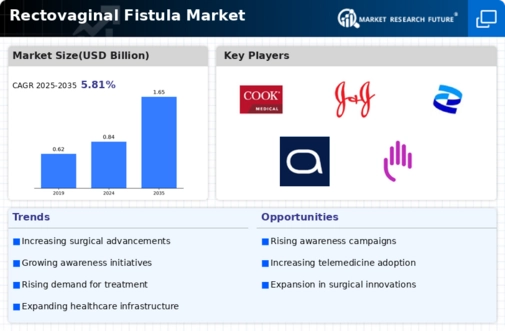Market Trends
Key Emerging Trends in the Rectovaginal Fistula Market
Market Trends of Rectovaginal Fistula Market
-
Growing Prevalence : The incidence of rectovaginal fistulas (RVFs) is increasing, driven by factors such as rising cases of obstetric complications, pelvic surgeries, and inflammatory bowel diseases. This growing prevalence is spurring demand for specialized medical devices and treatments, expanding the market.
-
Advancements in Surgical Techniques : Innovations in surgical methods, including minimally invasive procedures and improved suturing techniques, are enhancing treatment outcomes for RVFs. These advancements contribute to market growth by offering patients less invasive options and quicker recovery times.
-
Development of New Technologies : The market is witnessing significant developments in technology, including the introduction of advanced imaging techniques and new surgical tools. Innovations such as robotic-assisted surgery and novel biomaterials for repair are driving growth by improving precision and patient outcomes.
-
Increasing Awareness and Diagnosis : There is a growing awareness among healthcare providers and patients about RVFs, leading to increased diagnosis and treatment. Enhanced diagnostic tools and better awareness campaigns are contributing to more accurate identification and management of RVFs.
-
Rising Demand for Customized Solutions : Patients and healthcare providers are seeking more tailored treatment options. The demand for customized surgical solutions, personalized care plans, and specific biomaterials for fistula repair is driving growth in the market.
-
Expansion of Healthcare Infrastructure : The development of healthcare infrastructure, particularly in emerging markets, is facilitating access to advanced treatments for RVFs. Improved facilities and better access to specialized care are contributing to the market's expansion in these regions.
-
Regulatory Approvals and Guidelines : Regulatory agencies are increasingly approving new treatments and devices for RVFs. The establishment of clear guidelines and standards for treatment is promoting market growth by ensuring safety and efficacy in available solutions.
-
Focus on Research and Development : Companies are investing heavily in research and development to innovate and improve treatments for RVFs. This focus on R&D is driving market growth by bringing new and effective solutions to the forefront.
-
Collaborations and Partnerships : The market is experiencing a rise in collaborations between medical device manufacturers, healthcare providers, and research institutions. These partnerships are fostering innovation and expanding the availability of advanced treatment options for RVFs.
-
Growing Geriatric Population : The increasing elderly population is contributing to the rise in RVF cases due to higher incidences of conditions that can lead to fistulas. This demographic shift is driving demand for specialized treatments and contributing to market growth.
-
Patient-Centric Approaches : There is a shift towards patient-centric approaches in the management of RVFs. Emphasis on improving patient quality of life, reducing recovery times, and providing comprehensive care plans is shaping market trends and fostering growth.
These trends collectively highlight the evolving landscape of the rectovaginal fistula market, driven by technological advancements, increased awareness, and a focus on patient-centered care.








Leave a Comment